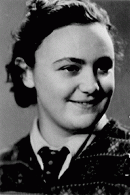
Tania Marcus
Born: June 16, 1928
Vilna, Poland
Tania grew up in Smorgonie, a Polish town where Jews constituted more than half of the population. Her father was a successful businessman who sold farming equipment and purchased flax for export. Her grandfather, an affluent merchant, traveled frequently and brought the first truck to Smorgonie. The Marcuses took part in the town's vibrant Jewish culture, attended the theater, and hosted discussions about art in their home.
1933–39: On September 1, 1939, German troops invaded Poland, triggering World War II. Sixteen days later, Soviet armies drove in from the east and occupied Smorgonie. Tania was just entering the fifth grade. Soviet authorities quickly began to implement communist policies, seizing the businesses, assets, and valuables of those individuals deemed “capitalists.” The Marcus family lost their businesses and much of their property. Tania's Jewish school was converted into a Soviet school, where classes were taught in Russian.
1940–44: On Sunday, June 22, 1941, the German army invaded the Soviet Union and occupied Smorgonie that same day. The Marcuses fled eastward to Lebedev, but were soon captured. Tania returned home with her mother and older sister. She soon learned that an SS mobile killing squad had shot her father. Her younger brother, Nathan, was retrieved from Lebedev, and, a few weeks later, the family was forced to move into the Smorgonie ghetto. Two years later, the Marcuses were transported to the Kovno ghetto. In March 1944, the SS shot more than 1,000 young children there, including nine-year-old Nathan.
Evacuated to the Stutthof concentration camp, Tania, her mother, and older sister were sent on a death march in January 1945. Tania contracted typhus and lost consciousness. When she awoke from the coma, she realized that they had been liberated by Soviet troops. Tania became a Hebrew teacher in several Jewish displaced persons camps in Germany and immigrated to the United States in 1950.

